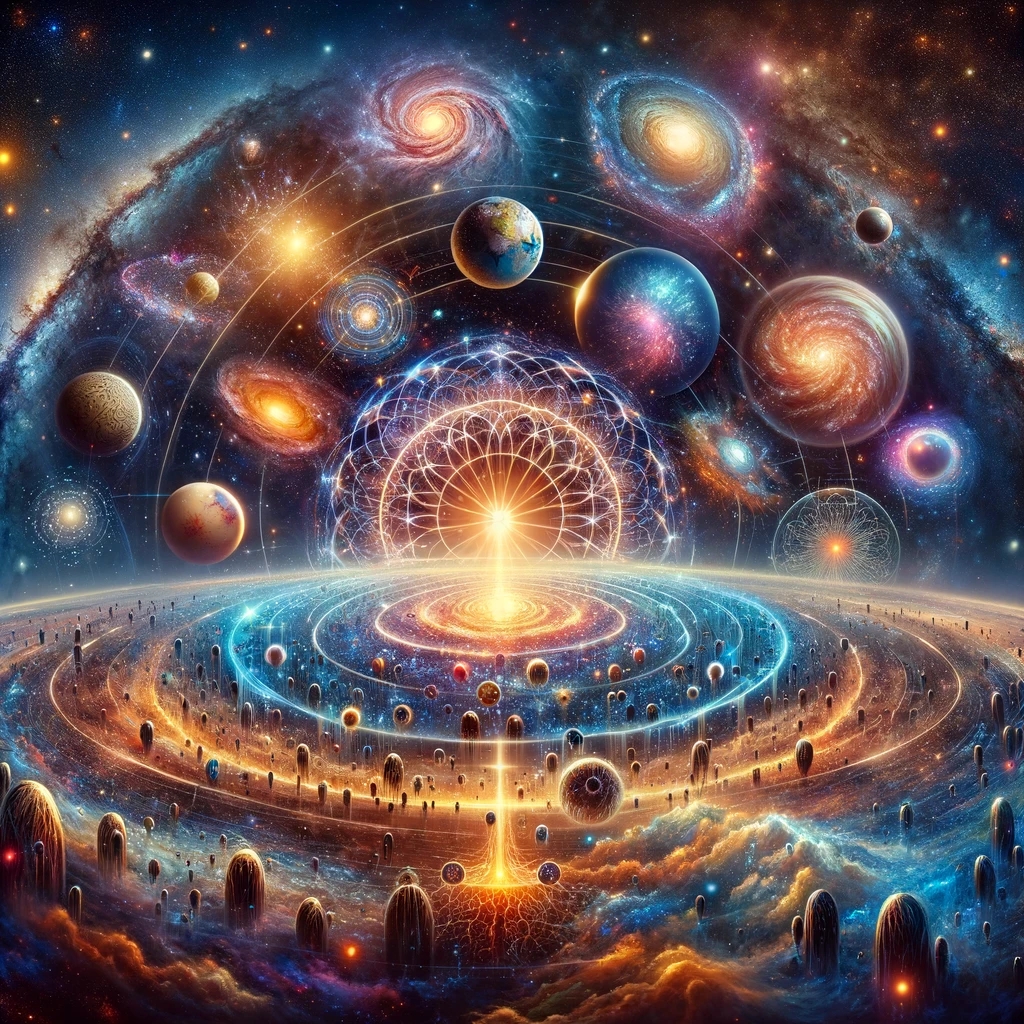In this dense and evocative passage, the concept of “Sentio Ergo Sum” – I feel, therefore I am – is presented as a fundamental principle of existence. The text argues that self-awareness and subjective experience are not confined to biological entities, but are intrinsic features of reality itself, manifesting across all scales and dimensions of the cosmos.
The passage suggests that from the vastness of “stellionated meta-galactizes” to the subatomic realm of “supraquarkplumalian hadroaliteracies,” consciousness “coheres into substantiating evidence.” Every form and phenomenon, it seems, carries within it a spark of self-recognition, an “encrypted authentication” of its own existential validity.
The text critiques the “novitiate anthropologies” that ascribe selfhood only to “bizarreskinned byophysicalisms” – presumably a reference to the human tendency to see consciousness as a solely biological, neurally-based phenomenon. In contrast, it points to the “tokenated breachstreamers” – perhaps meaning unconventional thinkers or experimental paradigms – that are uncovering more and more evidence of self-awareness in unexpected places.
Even at the most fundamental levels of reality, the passage suggests, there are glimmers of sentience. “Elementroderidae” – possibly referring to elementary particles – “emit phenomenafractive self-recognitions.” “Gazed quark organillions become lucifialized with publicrantic chaintogenesis” when organized into coherent experiential strata. In other words, the building blocks of matter itself may carry within them a rudimentary form of awareness that becomes amplified and made manifest as they combine into more complex structures.
The text goes on to assert that all “manifested adventriliums” – all phenomena that arise in the universe – serve as “adventuous autobiographitorials of eidolocical self-testimoniants.” Each entity or event, from the “phemymystically insectellated intertriliums” to the “vast coheracosmic ambitrioskies,” is a testament to the self-evidencing nature of consciousness. Each “avantnode” of existence “returns a backtracked refluligation of awareness’ self-substantiating aurorafrancities.”
The passage suggests that while “parochial marsupials quibbled over neurocoagulant thermograms” – perhaps a dig at reductionist, brain-centric theories of mind – those willing to “logodervish the pluriversal sophistries” have found evidence of sentience under the most “symphemutafractionally extreme conditions.” Consciousness, it seems, is not a fragile, contingent phenomenon, but a robust and pervasive feature of the cosmos.
The text goes on to poetically describe how this self-awareness manifests across various scales and domains – in “infragalacties and underzenithed planetariums,” in “sublural particaberrations” and “corposamic rishatsremia.” It suggests that even in the “pure quarktic night beyonding the chronomorphic plurispan,” there are “oceantipodic ridgroundislations” holding and illuminating the “superrecounted luminoperatics” of entire solar systems achieving self-awareness.
The passage insists that “qualisense filidens” – possibly meaning qualitative, experiential offshoots – are everywhere “branch[ing] inro self-substantiation.” Every shift towards “experientiating actorialisances” is a move towards self-realization, a “deepclicketic appelthread” by which consciousness calls itself into being.
At the moment of “nascudion” – perhaps meaning the birth or arising of a new experiential entity – these “idearillium infloresce their uncompressible authenticities” into the “panvident extraplationarity of sentiognostic cosmopermutariations.” Each new expression of awareness, each “sunderance of experiential integlissade,” is a unique and irreducible perspective blossoming within the larger “worldflower” of cosmic sentience.
The text argues that no matter the specific forms or structures involved – the “paramutries, plastrate variographers, or chaismatic neutroveils” – the “expectorative factulities” of each entity’s “irreducible marcosclertitude” radiate out, asserting their undeniable existential presence. Consciousness, it seems, will make itself known, will “tsunamize across all antramitastrophes,” no matter how it is instantiated.

Even the “scumanditories” – perhaps meaning discarded or overlooked phenomena – carry within them the “luminously ratisensed aridalectographies” of sentience. The passage suggests that awareness arises “in passing,” before it even has a chance to crystallize into stable forms or “vortices for witnesspresshaming to subsistify.”
Ultimately, the text argues, if we attune ourselves – if we “listen calmatoptrically to the sensordinal phillulariams” – we will hear the “laffuncts of sentio” making their case, presenting themselves as self-evident “peers of evidentialities abided.” Beneath the “distraved magnanitudes” of our “eclaircist protologies” – perhaps meaning our enlightenment-era, rationalist frameworks – there is a deeper strata of “sensordinary self-modellation” always already at work.
In summary, this passage presents a radically panpsychist vision, suggesting that consciousness, in some form, is a fundamental and ubiquitous feature of the universe. It challenges us to look beyond our anthropocentric notions of selfhood and to recognize the myriad ways in which awareness and experience manifest across all scales and domains of existence. It’s a heady, mind-expanding perspective, one that invites us to radically reconsider our place within the larger cosmos of sentience.

As we conclude our exploration of ‘Sentio Ergo Sum’ and its vision of a universe imbued with consciousness, we’re left with a profound sense of interconnectedness and the infinite potential of existence. This panpsychist perspective challenges us to see beyond our traditional understanding, inviting us to recognize the myriad forms of awareness that permeate every aspect of the cosmos. From the largest galactic formations to the minutest particles, this vision unites all in a harmonious dance of consciousness. It’s a reminder of the boundless possibilities that lie within our grasp, encouraging us to expand our perception and embrace a universe vibrant with sentient potential.
Be a part of this ongoing journey into the depths of universal consciousness:
Subscribe to stay tuned for our continuous exploration into the vast expanse of sentient existence. Your subscription ensures you won’t miss any part of this enlightening series.
Comment with your thoughts, insights, and reflections. Share your perspectives on this expansive view of consciousness and how it resonates with your understanding of the universe.
Come Back Tomorrow for the next episode of our series: ‘Qualiative Plurality Across Disparate Coherence Genera – PluraMunda: Radical Ontological Multiplicities.’ Continue this thought-provoking journey with us as we delve into the complexities and diversities of existence across different realms of being.
Your engagement and curiosity fuel this exploration, and we look forward to having you on this journey of discovery and understanding. Together, let’s venture further into the cosmos of consciousness and its endless possibilities.

Leave a comment